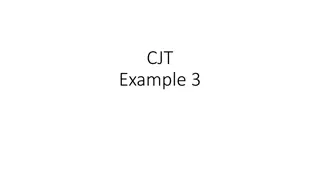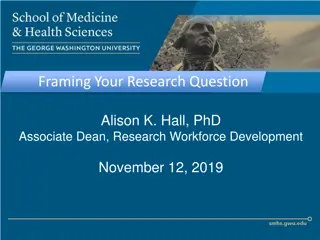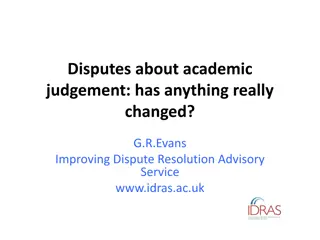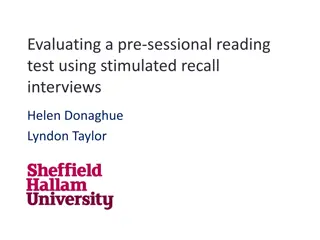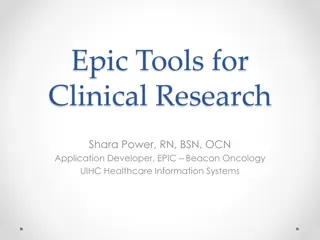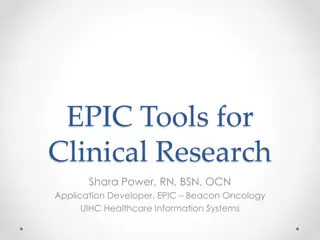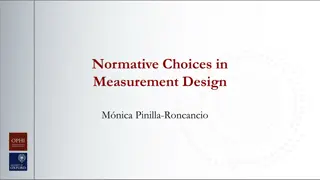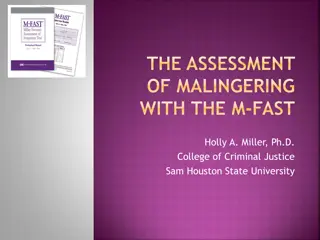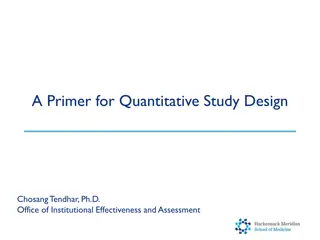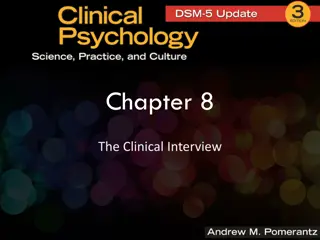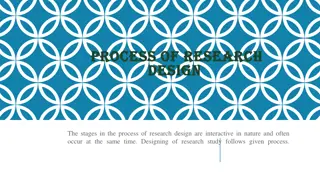Clinical Judgement Test: Research Question Relevance and Study Design Assessment
This document presents a Clinical Judgement Test focusing on the relevance of a research question and the appropriateness of the study design. Candidates are evaluated on their critical review skills and ability to assess both strengths and weaknesses of the research methodology employed. The test aims to measure candidates' clinical application and decision-making abilities based on knowledge of disease pathophysiology and evidence-based practices. Annotations and discussions on specific case management scenarios are required within a given timeframe.
Download Presentation

Please find below an Image/Link to download the presentation.
The content on the website is provided AS IS for your information and personal use only. It may not be sold, licensed, or shared on other websites without obtaining consent from the author. Download presentation by click this link. If you encounter any issues during the download, it is possible that the publisher has removed the file from their server.
E N D
Presentation Transcript
CJT Example 5
Clinical judgement test Aims Test clinical application and ability to justify clinical decision making Knowledge of disease pathophysiology Knowledge of the evidence base on which decision are made NOTE: IN THIS CASE CANDIDATES WILL BE GIVEN 70 MINUTES TO REVIEW THE FOLLOWING PUBLICATION (THE TITLE, ABSTRACT AND DISCUSSION HAVE BEEN REMOVED QUESTIONS WILL RELATE TO THE MANAGEMENT OF A SPECIFIC CASE THAT WILL BE PRESENTED AT THE END OF THE PAPER
stop REVIEW THE ATTACHED DOCUMENT BY DOUBLE CLICKING ON THE LINK ABOVE THIS WOULD BE PRINTED FOR YOU TO ANNOTATE AS YOU NEED
Question 1 Discuss the relevance of the research question (10) Unacceptable The good generalist A new diplomate The advanced diplomate No critical review of question (suggest positives only) Bases relevance on risks of adverse effects alone Discusses each drug impacts on COX 1 and COX 2 and absence of therapeutic advantage of stacking Discuss combined role as non-selectice COX inhibitors working at same targets Discuss low dose use of PBZ and potential impact of FLUN in enhancing COX inhibition Discuss potential for increase adverse effects
Question 2 Is the study design appropriate to address the question (ignore any flaws)? (20) Prompt what is the study design, what are the strengths/weakness in this study design (generally) Unacceptable The good generalist A new diplomate The advanced diplomate Recognises 1 Recognises 2 components Recognises 3 components Randomised blinded controlled cross over study Mentions 1 Mentions 2 Mentions 3 Discusses benefits in terms of efficiency(require fewer animals) (balanced) removes confounding variables with each animal receiving both treatments Limitations Order effects is removed by randomisation Impact of carry over Effect of time order effects
Question 3 What are the strengths and weaknesses of the study methods, do any of these make the data unreliable (10) Unacceptable The good generalist A new diplomate The advanced diplomate Recognises 1 Recognises 2 Recognises 3 including key weakness Strengths: 1) Objectve assessment of lameness 2) Blinded to treatment, randomised order Weaknesses 3) no FLUNIXIN group makes study unreliable (4)
Question 4 What are the strengths and weaknesses of the study methods, do any of these make the data unreliable (20) Unacceptable The good generalist A new diplomate The advanced diplomate Recognises 1 Recognises 2 Recognises 4 including key weakness Strengths: 1) Objectve assessment of lameness 2) Blinded to treatment, randomised order Weaknesses 3) no FLUNIXIN group makes study unreliable Recognises 1 Recognises 2 Recognises 3 1)IV flunixin yet oral bute 2)Bute only used at 2.2mg/kg 3)rather than using a loading dose 4)Variablility in responses
Question 5 Comment on the validity of the statistical methods(20) Unacceptable The good generalist A new diplomate The advanced diplomate Recognises 1 Recognises 2 Recognises 3 ANOVA is appropriate to compare continuous variables at different time points No explanation for using non-parametric test given continuous data Data of normality not reported Shapiro-Wilk test appropriate test for normality Recognises 1 Recognises 2 Recognises 3 Time points are not reported No mention of other evaluation time points Horses re-categorised after the data was collected Forelimb different to hindlimb (numbers)
Question 5 Comment on the validity of the statistical methods(20) Unacceptable The good generalist A new diplomate The advanced diplomate Recognises 1 Recognises 2 Recognises 3 ANOVA is appropriate to compare continuous variables at different time points No explanation for using non-parametric test given continuous data Data of normality not reported Shapiro-Wilk test appropriate test for normality Recognises 1 Recognises 2 Recognises 3 Time points are not reported No mention of other evaluation time points Horses re-categorised after the data was collected Forelimb different to hindlimb (numbers)
Question 6 The abstract of this study concludes: Conclusions and Clinical Relevance Administration of a combination of NSAIDs at the dosages and intervals used in the study reported here alleviated the lameness condition more effectively than did oral administration of phenylbutazone alone. This may attract use of combinations of NSAIDs to increase performance despite potential toxic adverse effects. Comment on this findings (10) Unacceptable The good generalist A new diplomate The advanced diplomate Recognises 1 Recognises 2 Recognises 3 There may be some value in hindlimb lameness Although other combined medication may be preferable - mentions safety That stacking is specifically discussed as without merit in BEVA clinical guidelines Mentions other combined therapy paracetamol
Question 7 Discuss how ethical review impacts on good science? (10) Prompt one horse died of right dorsal colitis as primary investigator what are your ethical obligations when running such studies Unacceptable The good generalist A new diplomate The advanced diplomate Recognises 1 Recognises 2 Recognises 3 Recognises risks associated with stacking and right dorsal colitis Discuss the need to break codes when randomisation studies have adverse effects Role of ethical review panel in considering potential adverse effects Need for ethical review in undertaking clinical studies not mentioned in this project (although has been removed)
Scores Question No answer (0) Unacceptable (2) Good generalist (4) New diplomate (6) Experienced diplomate (10) 1 2 2 3 5 5 6 7


